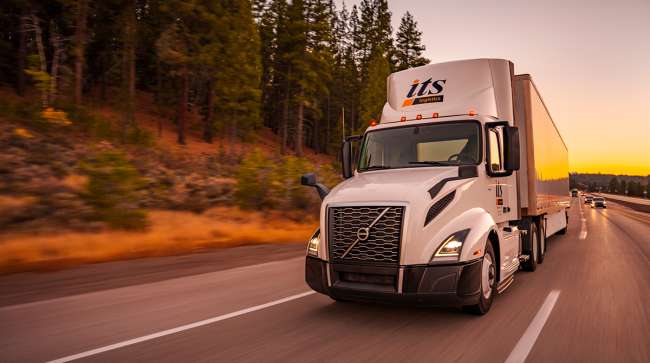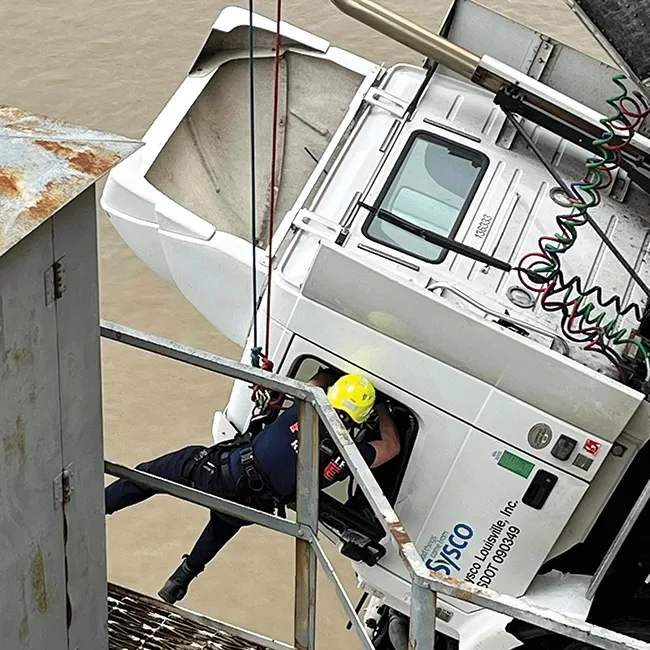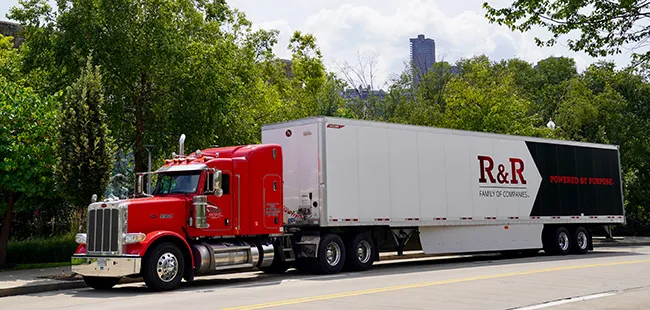Special to Transport Topics
Fleets Can Earn Driver Acceptance of Video Safety Systems

[Stay on top of transportation news: Get TTNews in your inbox.]
It’s a video that captivated the country on the evening news last March — a tractor-trailer dangling over the side of a bridge, 100 feet above the Ohio River in Louisville, Ky., and the daring rescue by firefighters that brought the driver to safety.
It’s the video immediately before that, however, that helped lead to criminal charges against another motorist who caused the dangerous crash. Forward-facing video from a camera in the cab of the tractor showed a passenger pickup as it swerved out of the oncoming lanes. The commercial truck driver, as recorded by the in-cab camera, was alert and following the speed limit, but was unable to avoid the collision. The heavy-duty truck was forced over the side of the Clark Memorial Bridge.
After the crash, the truck driver was cleared of any wrongdoing, and the pickup driver accused of causing the incident is set to stand trial for criminal charges in April.
That’s just one instance where video has exonerated drivers involved in crashes.
Nonetheless, truck drivers often are skeptical when their companies decide to deploy cameras in the cabs of their trucks.

Firefighters rescue the driver of a truck dangling over the Ohio River in an event that gripped the nation last year. Video captured by an in-cab camera helped exonerate the driver. (Louisville Division of Fire via AP)
Fleet managers say convincing drivers that onboard video systems are there for the driver’s benefit is key to ensuring a successful implementation of the technology.
Hayden Juzek, senior director of fleet operations at ITS Logistics, said his company has had in-cab and forward-facing cameras for at least six years.
“We are very clear in our communication,” he said. “It’s reducing liability for both the drivers as well as the company. It’s there to protect the drivers in case of dispute.”
Deep Dive
►How AI Is Unlocking New Value From Onboard Cameras
►Side, Rear Cameras Extend Visibility Around Tractor-Trailers
►Fleets Can Earn Driver Acceptance of Video Safety Systems
Dawn Johnston, vice president of risk management at the R&R Family of Cos., has spent the past year updating the company’s safety program and expanding the use of onboard video systems in its trucks. She found a fleet of drivers who were initially wary, and resistant to, the idea of cameras being installed in their trucks.
Johnston said communication is essential for bringing drivers on board with new safety programs. That includes making sure drivers have a part in the discussion when it comes to testing and piloting a new system.
“I have the noisiest drivers as my test subjects because they’re going be honest with me. And then usually by the time the demo is ended, they know which camera that we need for the company,” Johnston said. “We’ve already got their buy-in, and once we get the noisiest guys in, the rest all follow suit.”
She rolled out the program at R&R in stages — first by updating leases of company trucks to require use of a standard video system by owner-operators and contract employees; then by assigning the other drivers to safety coordinators and seeking volunteers to have the equipment installed in the trucks they were already driving.

Johnston
After the volunteers, Johnston targeted drivers who would benefit most from additional training; and finally, the holdouts.
“These are the tenured drivers who just don’t want somebody watching them,” she said, noting it’s important to have the right kind of conversations with these drivers.
Fleets with large proportions of owner-operators need to be intentional about rolling out video systems, Johnston said, noting many contract employees have dashcam equipment they have purchased independently for their own protection.
In such cases, a common objection is “I already have one, I don’t need yours,” she said. But in the event of a crash, video captured by the driver’s own dashcam system might not be immediately available to fleet managers.
She noted that once drivers are accustomed to the video systems, they ask for clips for personal use, such as a near-miss of an animal running across the road or a potential crash they avoided.
Enhanced Driver Coaching
Mark Murrell, president of online driver training firm CarriersEdge, said forward-facing cameras have become almost standard equipment for modern trucks.
“Cameras have been a significant part of most of the forward-thinking companies’ safety plans for quite a while,” Murrell said.
How the video captured by the cameras is used, however, is rapidly evolving.
“When people first started putting in the cameras, it was kind of a save-your-butt approach,” Murrell said. “The camera will prove that we weren’t at fault, and that was the mindset that most people had.”
Over time, that approach has shifted. Fleet operators are increasingly looking at the cameras as a coaching opportunity.
“You start to see a lot of things that are happening on the road that aren’t crashes, that are just problematic behavior, and in some cases, really good behavior,” Murrell said. “Having the ability to talk to drivers about that becomes very powerful on its own.”
Juzek of ITS Logistics agreed. His company reviews numerous events captured by the camera systems — not just crashes, but also swerves, hard braking and other critical events triggered by the camera’s protocols.
As an example, he pointed to an incident the company often highlights for drivers — a vehicle cuts off a truck and strikes a guardrail. The front-facing camera shows the incident, but the cab-facing camera shows valuable information as well.
“You’re able to actually promote the driver’s reaction time, their level of focus,” he said. “You can see the outward event. And then you can also see, how was the driver able to handle this? Was he at 10 and two? Was he distracted? Was he focused?”

Fleet operators such as R&R Family of Cos. have found that clear communication is key to gaining driver acceptance of onboard video systems. (R&R Family of Cos.)
Johnston said the coaching aspect of R&R’s system has been extremely valuable. Their camera system records events and then sends a link for the recording to the driver and the company.
“They get to see it as well as us, so as we’re talking to them, they get to explain it,” she said. Sometimes the company can see the driver did everything right and the incident was unavoidable.
Integration with another program has allowed the company to notice when a driver needs additional training to correct certain driving behaviors.
Johnston said since the company implemented its system, drivers have recorded greatly improved safety numbers.
Dispelling Misconceptions
ITS’s Juzek likened the captured video to sports film used by professional athletes.
“It’s a way to see where you can make enhancements on performance, safety,” he said.
Most drivers, once they understand the point of the cameras, are supportive of the technology.
David Bell, CEO of CloneOps.ai, discusses the impact of AI on the trucking industry. Tune in above or by going to RoadSigns.ttnews.com.
“I think one of the biggest misconceptions is that dash cameras are for punishment. That’s not the case. The primary goal is protection and prevention, not surveillance,” Juzek said.
He said he makes sure new hires learn during the onboarding process that the camera isn’t “always on.” It only turns on when the system detects a recordable incident, such as hard braking, a collision or high speed.
CarriersEdge’s Murrell said it is important to combat the misinformation about the video systems.
“There’s always miscommunication and sort of bad information out there about what the inward cameras are doing and how they’re spying on you every minute of the day,” he said. “People think that the camera’s watching them when they sleep and stuff like that. Those are myths that have to be dispelled.”
Another important factor is security. R&R’s Johnston said identity theft and cybercrime have led to the company losing loads in the past. Naturally, it is crucial for transportation businesses to keep bad actors out of their systems.
The video systems are connected to the internet, so they can be hacked. Johnston said R&R already uses multifactor authentication and controlled-access policies and is implementing single sign-in procedures as well. As a further precaution, personally identifying details and private data about the drivers are scrubbed out of certain systems.
Also, Johnston is the only person allowed to access video clips of crashes and send them on to law enforcement.
Murrell said fleets should be asking hard questions about cybersecurity when meeting with any technology vendor.
“Ask the vendors what the security is. Ask how to ensure that it is locked down sufficiently so that the data is protected,” he said. “Data privacy is not taken nearly as seriously as it should be. Data security is not taken as seriously as it should be. One of the biggest issues that we see is that people just end up exposing themselves because they don’t have secure passwords on their accounts. They don’t use multifactor authentication, or they just outright send private data through open unsecured email.”
Want more news? Listen to today's daily briefing above or go here for more info
Looking ahead, Juzek said he thinks artificial intelligence and detection systems will learn to work more cohesively. He would like to see a system that gives a driver a “scorecard” at the end of each run, detailing safety wins and areas where the driver might need to improve.
“I think one of the biggest challenges you have to fight is complacency or bad-habit stacking,” he said. “You could be building good habits, or you could be building bad habits.”
Onboard video-based safety technology can help drivers improve their performance and reinforce good driving behavior.
“It really allows that consistent feedback to help correct when we don’t have a driver trainer present,” Juzek said.





